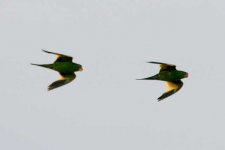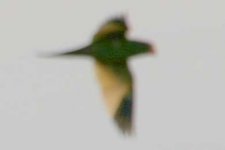Fulmar
Well-known member
There is some confusion about a species of Parakeet that formerly was known as the Canary-winged Parakeet / Brotogeris versicolurus. According to the AOU (American Ornithologist’s Union), this species was split into the Brotogeris chiriri / Yellow-chevroned Parakeet and the Brotogeris versicolurus for which the English name was changed at the same time from Canary-winged Parakeet to White-winged Parakeet. Also Sibley uses these new names.
In the Birdforum Birds Database, the Brotogeris versicolurus is IMO thus wrongly listed as “Canary-winged Parakeet”. The Brotogeris chiriri is correctly listed as Yellow-chevroned Parakeet.
Because of this confusion I think that the picture that is currently selected in the BF Database for the Brotogeris versicolurus is also wrong and is in fact a Brotogeris chiriri. The versicolurus should have some white visible in the wing and would have a bare loral (see http://fog.ccsf.cc.ca.us/~jmorlan/sfparrots.htm for identification clues).
I found out about this because I had photographed a confirmed Brotogeris versicolurus / White-winged Parakeet in California and became confused. Although the quality of the photo is very bad, I decided to upload it anyway, because it would currently be the only photo of a White-winged Parakeet at BF if my theory is correct.
What do you think?
Peter
In the Birdforum Birds Database, the Brotogeris versicolurus is IMO thus wrongly listed as “Canary-winged Parakeet”. The Brotogeris chiriri is correctly listed as Yellow-chevroned Parakeet.
Because of this confusion I think that the picture that is currently selected in the BF Database for the Brotogeris versicolurus is also wrong and is in fact a Brotogeris chiriri. The versicolurus should have some white visible in the wing and would have a bare loral (see http://fog.ccsf.cc.ca.us/~jmorlan/sfparrots.htm for identification clues).
I found out about this because I had photographed a confirmed Brotogeris versicolurus / White-winged Parakeet in California and became confused. Although the quality of the photo is very bad, I decided to upload it anyway, because it would currently be the only photo of a White-winged Parakeet at BF if my theory is correct.
What do you think?
Peter






